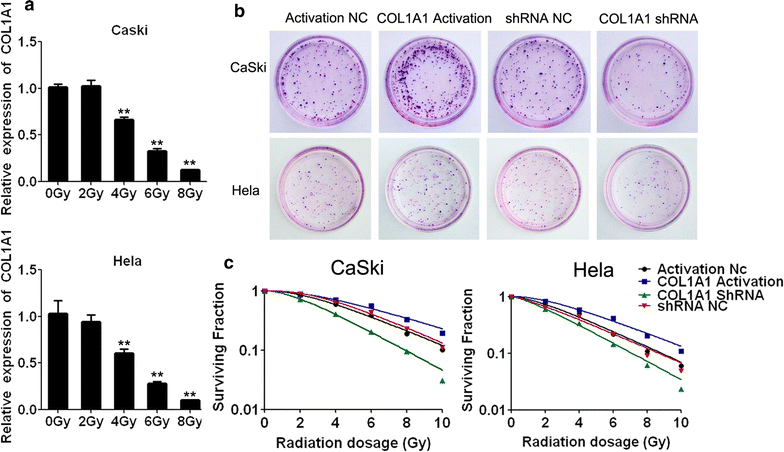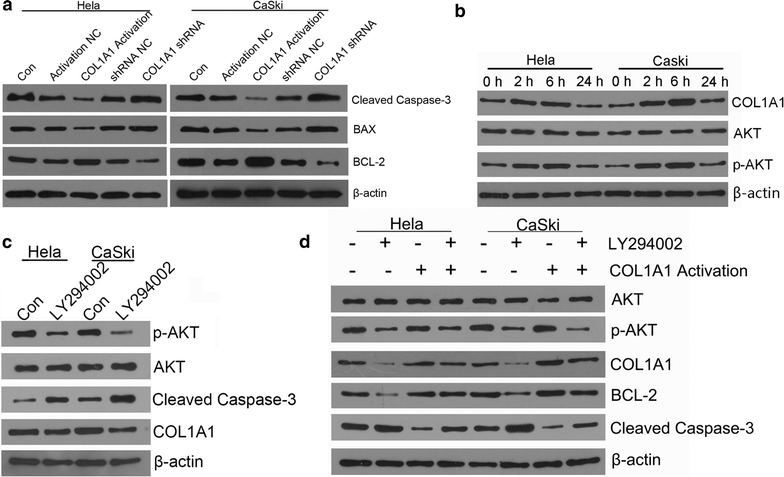Regulatory effects of COL1A1 on apoptosis induced by radiation in cervical cancer cells
- PMID: 28775672
- PMCID: PMC5534093
- DOI: 10.1186/s12935-017-0443-5
Regulatory effects of COL1A1 on apoptosis induced by radiation in cervical cancer cells
Abstract
Background: Cervical cancer is a common cancer of women in developing countries, and radiotherapy still remains its predominant therapeutic treatment. Collagen type I alpha 1 (COL1A1) has been shown to have a radioresistance effect in previous studies. However, such effect of COL1A1 has not yet been revealed in cervical cancer.
Methods: Expression of COL1A1 in cervical cancer tissues and normal tissues was assessed by qRT-PCR and immunohistochemistry. The effect of COL1A1 on radioresistance of human cervical cancer cell lines HeLa and CaSki was assessed using the colony formation assay. Apoptosis alterations were analyzed by flow cytometry. In addition, western blotting was used assessed the alterations of several critical apoptosis and signaling pathway related proteins.
Results: The expression of COL1A1 was significantly increased in cervical cancer tissues compared with normal tissues at the mRNA and protein level. Further, based on COL1A1 knock down and COL1A1 activation cell models, a negative correlation was observed between COL1A1 expression level and radiosensitivity. Moreover, the findings are further supported by apoptosis analysis that COL1A1 activation could inhibit the apoptosis of cervical cancer cells. Subsequently, a significantly decreased expression of p-AKT and Bcl-2, increased expression of Caspase-3 were observed in the LY294002 plus radiation group compared with radiation alone group, while these influences caused by LY294002 or X-ray radiation were reversed after COL1A1 activation.
Conclusions: To our knowledge, this is the only study to profile the mechanisms that COL1A1 plays a crucial role in cervical cells anti-apoptosis induced by radiation. Therefore, our identification of radioresistance-related COL1A1 in cervical cancer could be a starting point to explore the function of collagens, adding a new dimension to our understanding of the cervical cancer, assisting cancer biologists and clinical oncologists in novel therapeutic strategies.
Keywords: Apoptosis; COL1A1; Cervical cancer; Radioresistance.
Figures






References
-
- Fu JH, Gao Z, Ren CC, Shi YG. Comparison of clinical efficacy of three different neoadjuvant approaches (chemotherapy combined vaginal intracavitary irradiation, neoadjuvant chemotherapy alone or radiotherapy) combined with surgery for patients with stage Ib2 and IIa2 cervical cancer. Asian Pac J Cancer Prev. 2013;14(4):2377–2381. doi: 10.7314/APJCP.2013.14.4.2377. - DOI - PubMed
LinkOut - more resources
Full Text Sources
Other Literature Sources
Research Materials
Miscellaneous

